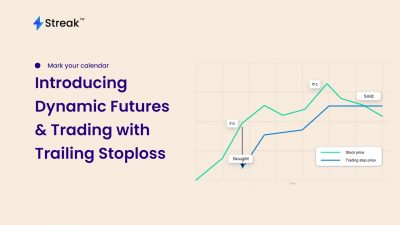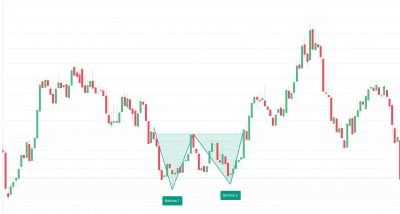While developing strategies, we often come across instances when we need to create time based conditions. For eg. If you want to create a strategy but you want to avoid trading during certain time of the day, like the start of the session when the volatility is extremely high. Or you might want to develop a strategy to trade only on each weekly expiry day. Streak provides many options to the users to create such conditions in your strategy.
In this article, I will teach you how you can use various time based indicators and options available on the Streak Platform. So let’s get started.
1) Opening Range Indicator
The opening range indicates high and low security prices for a certain time following the opening of the market. Day traders pay attention to a stock’s starting range since it might indicate sentiment and price movement for the day.
The ‘opening range’ indicator allows you to create your conditions based on the Open, High, Low, Close of the 1st candle of the day. The time frame of the 1st candle can be anything (i.e it can be the 1st 1, 3, 5, 10, 15, 30 min or 1 hr candle also).
Example:
Entry Condition : If today is a gap down opening but later during the day, the 5 min candle crosses above the 1 hour opening range high
Exit Condition : Stoploss and Target

2) Candle Time Indicator
This is the latest addition to Streak in the family of time based indicators. It is the most powerful indicator as it gives users very precise control over day of the week, hour or the day as well as the minute of the hour. The possibilities are immense. For instance, if you would want to trade at 2:21 P.M. on Wednesday of every week, this indicator can make it happen. One application of this indicator is BTST strategy. Let’s create a strategy and see how this indicator works.
Example:
Entry Condition : If EMA 50 Crosses above EMA 200 between 11 AM to 1 PM on 5 min time frame
Exit Condition : At 2:45 P.M (Exit will trigger when 2:45 5 min candle closes i.e at at 2:50)
This example lets us learn about the hour and minute level control. For day level control, we can use the conditions as follows :
This condition will allow you to fix the day of the week as 3 i.e Wednesday.
Important Note:
The Indicator parameters will also depend on the base timeframe of the strategy. Lets have a look at an example to exit at 3:10 P.M with base timeframe as 1 min V/s 5 min.
1 Min base Timeframe:

Exit will trigger when 15:09 1 min candle closes i.e at 15:10
5 Min base Timeframe

Exit will trigger when 15:05 5 min candle closes i.e at 15:10
Video:
3) Nth Candle Indicator
The Nth candle indicator lets us access the OHLC value of any candle of the day. It is similar to the opening range indicator but instead of only the 1st candle, this works for all the candles including the 1st candle of the day. We will again understand this with an example.
Example:
Entry Condition : If the 2nd hourly candle of the day (10:15 to 11:15) is green
Exit Condition : 1% Stop-Loss 2% Target
4) With the Time settings under ‘Advanced’ settings
Streak provides users an option to control the entry time of the strategy. The option is available under the ‘Advanced’ option at the bottom of the create strategy page. Please note that this option applies only to entry. The exit can happen at any time as it is not determined by the time selected under this setting. To better understand this setting and to differentiate it from the ‘Candle Time’ indicator which we discussed in section 2, let us create the same strategy that we did with the ‘Candle Time’ indicator but this time, we will be using the time settings under ‘Advanced’ settings.
Notice the difference here. We have removed the ‘Candle Time’ indicator from the entry conditions and we have set the Start time as 11:15 A.M and the stop time as 01:15 P.M. Also, note that I have not removed the ‘Candle Time’ indicator from the exit condition. That’s because this ‘Start Time’ ‘Stop Time’ applies only to entries. If the stop time is 1:15 P.M, it does not mean that the position will be exited at 1:15 P.M. It simply means that no new entries will be taken after 1:15 P.M.
5) Prev N Indicator
Prev N indicator is a very simple indicator. It allows to access the values of the historical candles and the best thing is that it also has a time-frame selection option that allows to select the OHLC values of different time-frames without using the multi-time frame indicator. The difference being that multi-time frame can provide indicator values also but Prev N will provide only OHLC values.
Let us take an example to understand this:

In these conditions, we have used 5 min as the main time-frame of the strategy. We are checking SMA crossover on 5 min time-frame. Along with that, we are also checking if today’s open was higher than yesterday’s high. Here we have used the Nth candle to get the day’s open price and the Prev N indicator to get the previous day’s high price.
6) Multi-Timeframe Indicators
Multi-Time frame analysis is a technique wherein traders look at more than one time frame to carry out their analysis and take trades or create scanners. Lets create a scanner using the Multi-Timeframe Indicator to understand it.
We will create a scanner to Identify all the Nifty 500 stocks where SMA 50 is higher than SMA 200 on 15 min as well as the hourly timeframes:

Note: You must use the lowest timeframe of your strategy/scanner as the main timeframe and use the multitimeframe indicator to create conditions on higher timeframes.
There are two Multitimeframe Indicators. Multitimeframe and Multitimeframe completed. Multitimeframe Completed indicator checks condition only on the completed candle of the higher Timeframe whereas Multimteframe indicator is capable of checking on the ongoing incompletely formed higher timeframe candle also.
The interesting thing about the multitimeframe indicator is that you can create conditions on various timeframes like Weekly, Monthly, 2 hours, 3 hours, 4 hours, etc. You can watch our multitmeframe analysis webinar at : https://www.youtube.com/watch?v=08eQ-aCbl4w
Conclusion:
There are instances when a trader has to have complete control over the timing of their trades. On the Streak platform, there are a variety of conditions and indicators that allow users to create time-based conditions with ease. In this post, we spoke about 5 distinct indicators and settings that provide you minute-level control and flexibility when creating multi-time frame conditions..
Disclaimer: The information provided is solely for educational purposes and does not constitute a recommendation to buy, sell, or otherwise deal in investments.









